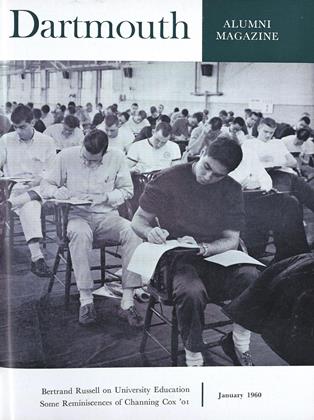HESIOD: THE WORKS AND DAYS, THE-OGONY, THE SHIELD OF HERAKLES.
January 1960 JOHN B. STEARNS '16Translated by Richmond Lattimore '26.Ann Arbor: University of Michigan Press,'959- 241 pp. $3.95
Professor Lattimore's Hesiod will add to the merited renown of Hesiod and his translator; both are dynamic poets. Such poetic marriages are often poetically fruitful, to be sure, but in this case new forces are at work. (Outer space? I know only that last week on my first transcontinental jet flight I chose Hesiod (Ninth Century B.C. friend) and Lattimore (friend Of later date) as companions and found them beguiling and helpful in jet travel. Home at last, I can still recommend both these friends and jets.)
Hesiod gives help for daily life with his pithy, farmer wisdom: "Do not let any sweet talking woman beguile your good sense with the fascinations of her shape. It's your barn she's after." Hesiod's mind "cries out against the wicked purpose of men, so that the people must pay for the profligacy of their rulers." Hesiod's heart tells him "look, badness is easy to have, you can take it by handfuls... but between us and virtue the immortals have put what will make us sweat." Hesiod learned, too, that one should "drink deep ... when the bottle has just been opened, and when it's giving out: be sparing when it's half full} but it's useless to spare the fag end."
Lattimore's introduction is written with enviable - i.e., Hellenic - clarity. The reader learns that Hesiod in Boiotia, like Homer in lonia, inherited a well-developed tradition of epic poetry, which forbids the assumption that either poet is "primitive." Furthermore, Hesiod's Boiotian school of epic is shown to be parallel to, rather than derivative from, Homer's lonian school. The question of the relative merits of these two schools of epic is, quite properly, avoided, but a perspicacious reader , might be led at this point to review his own rules for distinguishing a major from a minor poet - a wholesome hobby for any reader.
The book includes ingeniously contrived genealogical tables and a glossary of personal names. It is adorned with drawings by Richard Wilt which are in keeping with the spirit of the book.
This reader (at an elevation of 30,000 feet for. the first time) found it pleasant to feel that Hesiod and he were nostalgic for, proud of, and amused after all by, the same old trifles, and we reached a tacit agreement that it is still helpful to keep as friends those
"...who possess the great and holy mountain of Helikon and dance there on soft feet by the dark bine water of the spring..."
 View Full Issue
View Full Issue
More From This Issue
-
 Feature
Feature"As I Remember..."
January 1960 By EDWARD CONNERY LATHEM '51 -
 Feature
FeatureDemocracy's Influence on University Education
January 1960 By BERTRAND RUSSELL -
 Feature
FeatureA Basic Classical Library
January 1960 By PROF. ROBIN ROBINSON '24 -
 Article
ArticleA Famed Collection and How It Grew
January 1960 By EVELYN STEFANSSON -
 Article
ArticleReligion in the Soviet Union
January 1960 By HENRY S. ROBINSON '51 -
 Class Notes
Class Notes1918
January 1960 By THOMAS E. SHIRLEY, W. CURTIS GLOVER
JOHN B. STEARNS '16
-
 Letters to the Editor
Letters to the EditorLetters to the Editor
DECEMBER 1971 -
 Article
ArticleGEORGE DANA LORD
August 1945 By JOHN B. STEARNS '16 -
 Books
BooksALL THE BEST IN THE MEDITERRANEAN
March 1952 By John B. Stearns '16 -
 Books
BooksTHE POETRY OF GREEK TRAGEDY.
July 1958 By JOHN B. STEARNS '16 -
 Article
Article"In Classic Dartmouth's College Halls"
DECEMBER 1966 By John B. Stearns '16 -
 Books
BooksTHE THREAD OF ARIADNE: THE LABRYINTH OF THE CALENDAR OF MINOS.
DECEMBER 1972 By JOHN B. STEARNS '16
Books
-
 Books
BooksFORESIGHTS IN COLLECTIVE BARGAINING.
January 1947 By C. E. Dankert. -
 Books
BooksThe Great Fight
SEPT. 1977 By DAVID BRION DAVIS '50 -
 Books
BooksVICTORIAN ORIGINS OF THE BRITISH WELFARE STATE
May 1961 By JOHN G. GAZLEY -
 Books
BooksNO BUGLES FOR SPIES.
JULY 1963 By MICHAEL CHOUKAS '27 -
 Books
BooksTHE MAD DOCTOR'S DRIVE.
DECEMBER 1964 By R.J.B. -
 Books
BooksBlack Pawl
February, 1923 By W. B. P.


